As a dog lover, choosing the right dog breed can be daunting. With so many breeds, finding a breed that fits your lifestyle and personality is important.
Two popular breeds in the schnauzer family that are often compared are the giant schnauzer and the standard schnauzer. Both are popular but differ in intelligence, loyalty, and protective nature.
Here we will delve into the characteristics of giant schnauzers vs standard schnauzers, outlining their physical attributes, temperament, and activity levels. We will also discuss Giant schnauzer vs standard schnauzer, their history, training needs, and potential health issues.
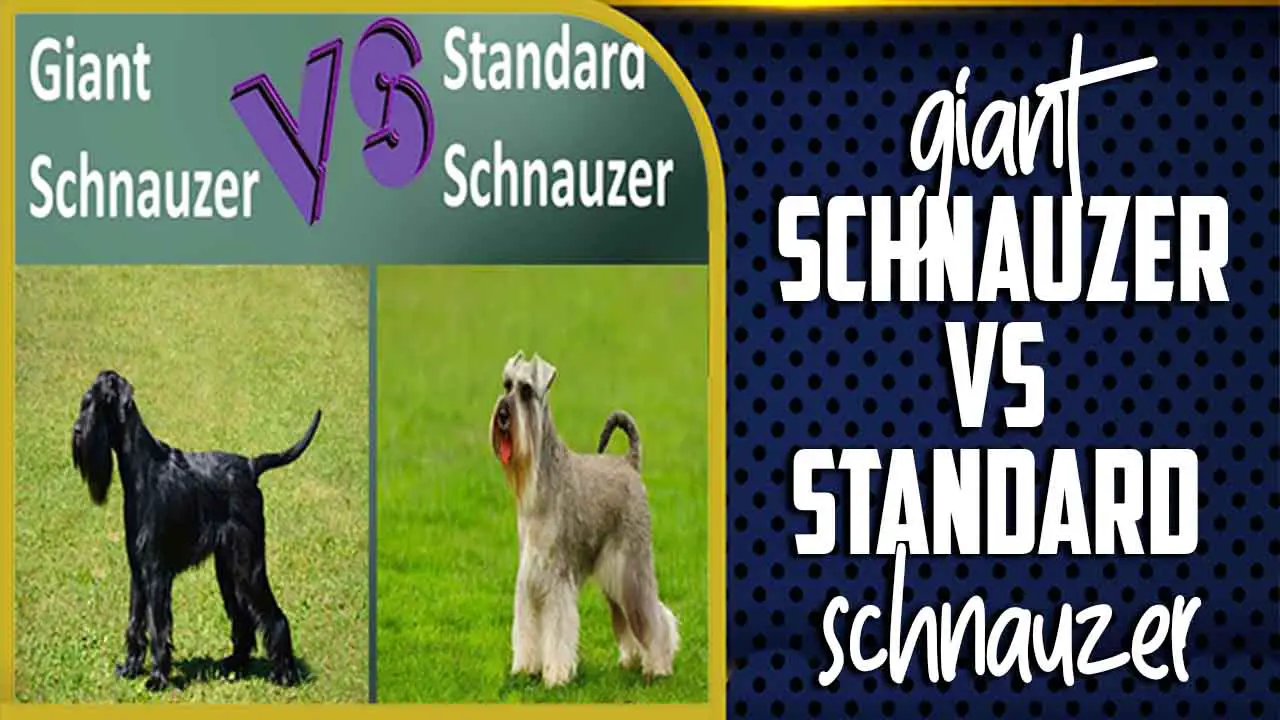
About Giant Schnauzer
The Giant Schnauzer is a large, powerful breed popular for its loyalty, intelligence, and protective nature. Originally bred in Germany in the 17th century, these dogs were handy as guard dogs on farms and police dogs. They stand at around 23-28 inches tall and can weigh up to 95 pounds, making them one of the largest breeds in the terrier group.
With their distinctive bushy eyebrows and beard, they have a bold, rugged appearance that commands attention. Despite their size, Giant Schnauzers are popular for being great family dogs.
They are affectionate with their owners and are protective of their families. They also get along well with children and make excellent playmates. However, they have a strong prey drive and can be aggressive towards other dogs and animals, so socialization and training are essential.
About Standard Schnauzer
The Standard Schnauzer is an elegant and intelligent breed that has been a favourite among dog lovers for years. This breed originated in Germany and was handy as a guard dog, rat catcher, and hunting dog. Standard Schnauzers are medium-sized dogs that stand around 18-20 inches tall at the shoulder and weigh between 35-50 pounds.
They have a distinctive appearance with their bushy eyebrows, beard, and moustache, which give them a wise and dignified look. Their wiry coat comes in various colours, including black, salt, pepper, and black and silver.
Standard Schnauzers are popular for their loyalty and affectionate nature towards their owners. They are also highly intelligent and require plenty of mental stimulation to stay happy and healthy. This breed is active and requires daily exercise, including walks, runs, and playtime.
Giant Schnauzer Vs Standard Schnauzer: Compare Between Both Breed
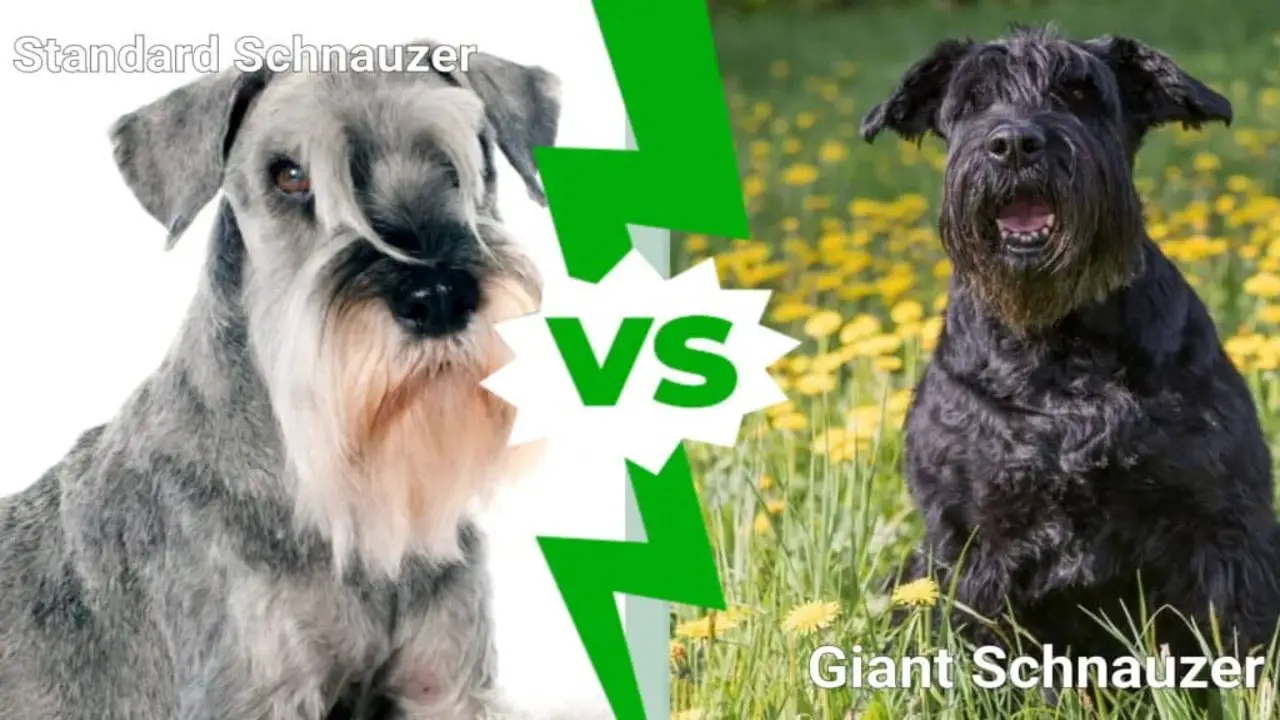
Regarding choosing a Giant schnauzer vs standard schnauzer breed, there are two popular options: giant and Standard. While both breeds share some similarities, there are also some notable differences that potential owners should consider.
Firstly, size is the most obvious difference between the two breeds – giant schnauzers are significantly larger than standard schnauzers, with an average weight of 80-100 pounds compared to the standard schnauzer’s average weight of 30-45 pounds. Here, we discuss the characteristics of a Giant schnauzer vs a standard schnauzer.
Both Characteristic
Knowing the characteristics of different dog breeds is essential, especially if you are considering getting a new furry friend. In the case of the Giant Schnauzer and Standard Schnauzer, it is important to understand the differences between them as they are two distinct breeds with unique personality traits, care requirements, and temperaments. Here are some bullet points on the characteristics of Giant Schnauzers and Standard Schnauzers:
Giant Schnauzer
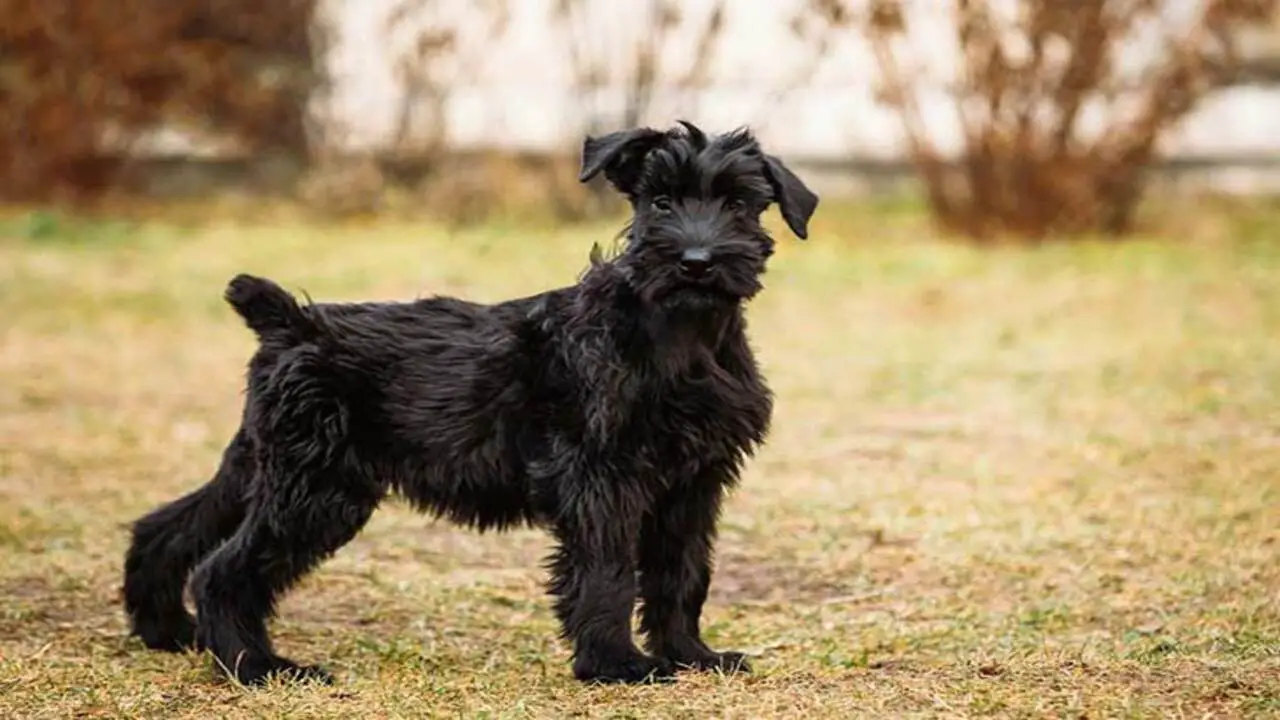
- Larger size, weighing between 70-100 pounds and standing 23-28 inches tall.
- Intelligent and highly trainable, with a strong desire to please their owners.
- They are protective and territorial, making them excellent guard dogs.
- Require regular exercise and mental stimulation to prevent boredom and destructive behaviour.
- Typically, they have a coarse, wiry coat that requires regular grooming and trimming.
Standard Schnauzer
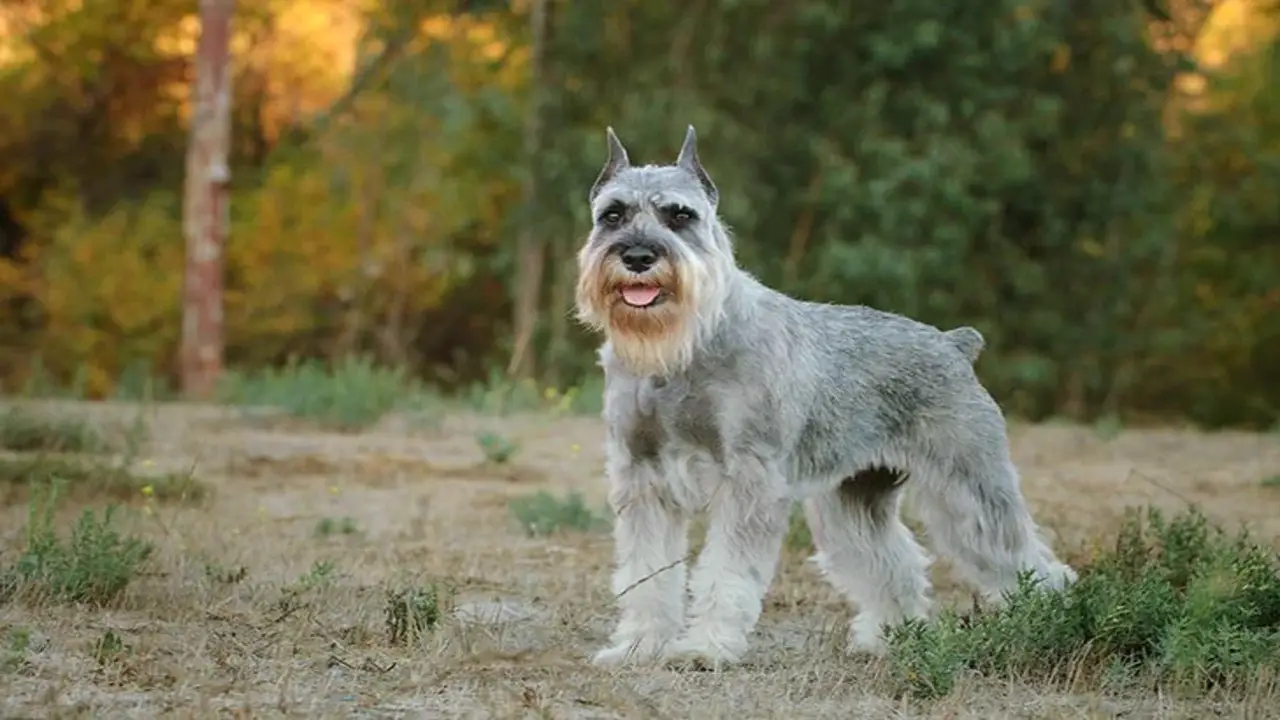
- Smaller than the Giant Schnauzer, weighing 30-45 pounds and standing 17-20 inches tall.
- Energetic, playful, and intelligent dogs that are easy to train.
- Good with children and make excellent family pets.
- Alert and protective, but not as territorial as the Giant Schnauzer.
- Have a distinctive, wiry coat that requires regular grooming and trimming.
Appearance
There are a few key differences in comparing the appearance of the Giant Schnauzer and the Standard Schnauzer. Firstly, the Giant Schnauzer is much larger than its standard counterpart, with a height of around 25 to 28 inches at the shoulder compared to the Standard’s 17 to 20 inches.
In terms of coat, both breeds have a wiry, double-layered coat that requires regular grooming, but the Giant Schnauzer tends to have a thicker and more abundant coat. The colours of the two breeds also differ, with the Giant Schnauzer typically being solid black or salt and pepper, while the Standard Schnauzer can be black, pepper and salt, or pure white.
Regarding facial features, the Giant Schnauzer has a more pronounced and square-shaped muzzle, with larger ears that stand upright. Meanwhile, the Standard Schnauzer has a slightly more rounded head with smaller, V-shaped ears.
Size
Regarding Schnauzers, two breeds are quite popular among dog lovers: the Giant Schnauzer and the Standard Schnauzer. However, one of the most significant differences between the two breeds is their size.
As the name suggests, the Giant Schnauzer is considerably larger than the Standard Schnauzer, with an average weight ranging from 75 to 95 pounds and a height of around 23 to 28 inches. In contrast, the Standard Schnauzer weighs between 35 to 50 pounds and stands at 17 to 20 inches.
Shedding
The shedding of Giant Schnauzers and Standard Schnauzers can vary greatly depending on several factors. Firstly, it is important to note that both breeds are considered low-shedding dogs, which makes them a popular choice for people who suffer from allergies but still want a furry companion.
However, the amount of shedding can differ between the two breeds. Giant Schnauzers have a thick, wiry coat that requires regular grooming to keep it in tip-top condition.
This type of coat does not shed excessively, but it does require more maintenance than the coat of a Standard Schnauzer. On the other hand, Standard Schnauzers have a softer coat that sheds less than the Giant Schnauzer’s coat but still requires grooming to keep it looking its best.
Temperament
The temperament of a Giant Schnauzer is often described as confident, assertive, and dominant, while a Standard Schnauzer’s temperament is considered lively, playful, and affectionate. Both breeds are intelligent and require a lot of mental and physical stimulation.
However, the Giant Schnauzer may be more challenging to handle due to their dominant nature, and they may need an experienced owner who can establish themselves as the pack leader.
On the other hand, Standard Schnauzers are more adaptable to different living situations and can be suitable for families with children and other pets. They are affectionate and playful, making them great companions. Socialization and training are crucial for both breeds, but the Giant Schnauzer needs to prevent any aggressive tendencies.
Coat
When comparing the coats of Giant Schnauzers and Standard Schnauzers, there are some notable differences. While both breeds have a wiry, thick coat, the coat of the Giant Schnauzer is typically longer and coarser than the Standard Schnauzer’s.
This is due in part to the fact that Giants are a larger breed and, therefore, require a heftier coat to protect them from the elements. The coat of the Giant Schnauzer tends to be more prone to matting and tangling, which means that it requires more grooming and maintenance than the coat of a Standard Schnauzer. However, a well-groomed Giant Schnauzer can be a truly impressive sight with proper care and attention.
Intelligence
Regarding intelligence, both the Giant Schnauzer and the Standard Schnauzer are popular for their high level of intelligence. However, there are some differences between the two breeds. The Giant Schnauzer is typically larger and more powerful than the Standard Schnauzer, giving them an advantage in certain situations.
They are also known to be more independent and less affectionate than their smaller counterparts. This independence can work in their favour regarding training, as they are less likely to become distracted or bored during training sessions.
On the other hand, the Standard Schnauzer is popular for being more affectionate and friendly, making it easier to train and more responsive to commands. They are also generally more adaptable to different living environments and are better suited for families with children.
Life Span
There are a few things to consider regarding the life span of giant and standard schnauzers. Generally speaking, giant schnauzers tend to have a slightly shorter life span than standard schnauzers, with an average life expectancy of 10-12 years compared to the standard schnauzer’s average of 12-14 years. However, it’s important to note that these numbers can vary depending on various factors, including genetics, diet, exercise, and overall health.
Activity Level
When comparing the activity levels of a Giant Schnauzer versus a Standard Schnauzer, it’s important to understand that both breeds have high energy levels and require regular exercise. However, the Giant Schnauzer tends to be more active and energetic than the Standard Schnauzer.
This is partly due to their larger size and muscular build, allowing them to participate in more strenuous activities such as running, hiking, and even agility training.
On the other hand, the Standard Schnauzer is also an active breed, but their smaller size and less muscular build make them more suited to moderate exercise, such as brisk walks and playtime in the backyard. While both breeds require daily exercise to maintain their physical and mental well-being, the activity level of a Giant Schnauzer may be too much for some owners to handle.
Trainability
Regarding dog breeds, one of the factors that many people consider is trainability. The Giant Schnauzer and Standard Schnauzer are two popular breeds that are often compared in this regard.
While both breeds are intelligent and capable of learning new commands, their trainability has some differences. Overall, the Giant Schnauzer tends to be more independent and stubborn than the Standard Schnauzer, making training more challenging.
Trainability Of Giant Schnauzer
- Giant Schnauzers are highly trainable dogs.
- They are intelligent and eager to please their owners, which makes them quick learners.
- Giant Schnauzers respond well to positive reinforcement training methods such as rewards and praise.
- They strongly desire to work and excel in obedience, agility, and other canine sports.
- Consistent patient training is essential for Giant Schnauzers to reach their full potential.
- Early socialization is crucial to prevent behaviour problems such as aggression towards strangers or other animals.
- Giant Schnauzers have a dominant personality and require a firm and assertive owner who can establish themselves as the pack leader.
- Training should be physical and mental to keep them engaged and prevent boredom.
Trainability Of Standard Schnauzer
- Standard Schnauzers are highly trainable dogs.
- They are intelligent, quick learners and eager to please their owners.
- They respond well to positive reinforcement training methods like treats, praise, and play.
- Regular training sessions and socialization can help these dogs to develop good manners and behaviour.
- They are good at obedience training and can be trained for advanced tasks like agility or therapy work.
- Training should start early and be consistent to prevent bad habits from forming.
Exercise Needs
Regarding exercise needs, both the giant schnauzer and standard schnauzer require a good amount of physical activity. However, the giant schnauzer is typically larger and has a higher energy level so they may require more exercise than their smaller counterpart. A daily brisk walk and playtime in the backyard may be enough for a standard schnauzer, but a giant schnauzer may benefit from longer walks, runs, and even agility training.
Exercise Needs Giant Schnauzer
- Giant Schnauzers are a high-energy breed that requires a lot of exercise.
- They need at least 30-60 minutes of daily exercise to maintain their physical and mental health.
- Regular exercise can help prevent obesity, a common health issue for Giant Schnauzers.
- They enjoy running, hiking, swimming, and playing fetch.
- Obedience and agility training can also stimulate this intelligent breed mentally.
- Exercise should be done in a safe and secure area, as Giant Schnauzers tend to wander and may not have good recall skills.
- Monitoring their exercise in hot weather is important to prevent heat exhaustion.
Exercise Needs Standard Schnauzer
- Standard Schnauzers require daily exercise to stay healthy and happy.
- A brisk walk or jog for at least 30 minutes a day is recommended for this breed.
- Interactive playtime, such as fetch or tug-of-war, can also be a great form of exercise.
- Standard Schnauzers are popular for their agility and love for training, making them great candidates for obedience or agility classes.
- Mental stimulation is equally important for this breed, so puzzle toys and games can greatly add to their exercise routine.
Grooming
Regarding grooming, the Giant Schnauzer and Standard Schnauzer have some differences pet owners should know. The Giant Schnauzer is a larger breed with a wiry coat that requires more maintenance than the Standard Schnauzer. This breast must be brushed for at least one week to prevent matting and tangling. Here are some possible bullet points on grooming Giant schnauzer standard schnauzer:
Grooming A Giant Schnauzer
- They requires much grooming due to their thick, wiry coat that sheds minimum needs.
- Need to be brushed at least twice a week to prevent matting and tangling.
- They should be trimmed or clipped every 6-8 weeks to maintain their shape and prevent matting.
- It may need to be stripped (removal of dead hair) occasionally to maintain the coat’s texture.
- It should be bathed as needed, usually every 2-3 months.
Grooming A Standard Schnauzer
- It has a double coat that is softer and more manageable than the Giant Schnauzer’s coat.
- It needs to be brushed regularly to remove loose hair and prevent mats.
- They should be trimmed or clipped every 6-8 weeks to maintain their shape and prevent matting.
- It may need to be hand-stripped occasionally to maintain the coat
Good With Family
When choosing a dog as a family pet, it’s important to consider their temperament and compatibility with children. The Giant Schnauzer and Standard Schnauzer are popular for being good with family and are popular breeds for families looking for a loyal and protective companion.
However, some key differences between the two breasts may influence your decision. The Giant Schnauzer is a large and powerful breed, weighing between 70-100 pounds, while the Standard Schnauzer is a medium-sized breed, weighing between 35-50 pounds. The Giant Schnauzer is popular for being fiercely loyal and protective of their family, making them a great guard dog.
However, they can also be stubborn and require a firm hand in training. The Standard Schnauzer is also loyal and protective but tends to be more energetic and playful, making it a great choice for families with children who want an active dog to play with.
Apartment Living
Regarding apartment living, both giant schnauzers and standard schnauzers are great choices for those looking for a furry companion. However, there are some key differences to consider between the two breeds. Giant schnauzers are larger, requiring more space to move around comfortably.
They also have a higher energy level and need more exercise to stay healthy and happy. On the other hand, standard schnauzers are smaller and more adaptable to smaller living spaces. They are more laid back than their larger counterparts, making them a great option for those who prefer a more relaxed lifestyle.
Health Problems
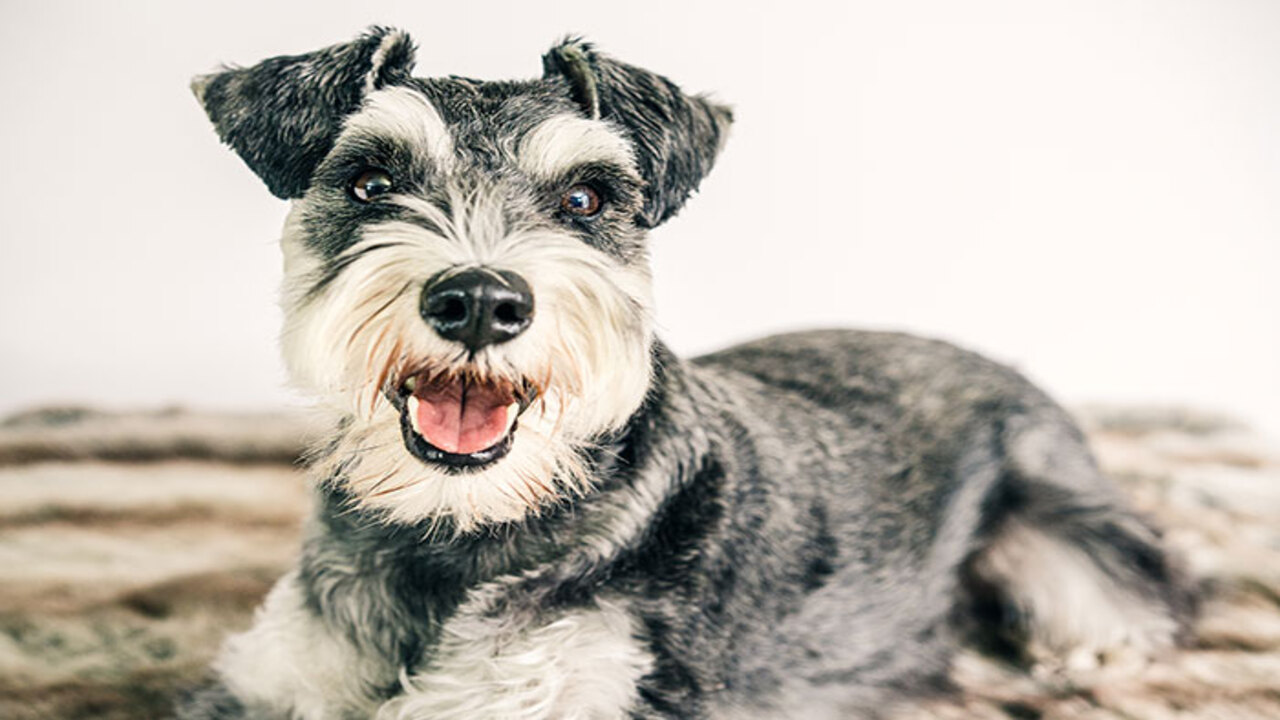
Regarding owning a schnauzer, it’s important to understand the potential health problems that can arise. The giant schnauzer and standard schnauzer are prone to certain issues, but the two have some differences.
Health Problems Gian schnauzerer
- Giant Schnauzers are prone to hip dysplasia, which is a condition that affects the hip joints and can cause arthritis and mobility issues.
- They can also develop eye problems such as cataracts, progressive retinal atrophy, and glaucoma.
- Another health issue that Giant Schnauzers may face is hypothyroidism, a condition where the thyroid gland doesn’t produce enough thyroid hormones.
- Bloat is another health condition that can affect Giant Schnauzers. Bloat occurs when the stomach fills with gas and twists on itself, which can be life-threatening.
- They may also be prone to skin problems such as allergies and pyoderma (a bacterial skin infection).
Health Problem standard Schnauzer
- Standard Schnauzers may be prone to hip dysplasia, a condition in which the hip joint doesn’t fit properly, leading to arthritis and pain.
- They may also be susceptible to eye problems, such as cataracts, progressive retinal atrophy, and glaucoma.
- Standard Schnauzers are at risk for Schnauzer Comedone Syndrome, which causes blackheads to form on the skin. This can lead to skin infections and other complications if left untreated.
- Like many breeds, they may also be prone to allergies, which can cause skin irritation, itching, and other symptoms.
- Standard Schnauzers may also be at risk for certain types of cancer, including lymphoma and osteosarcoma.
- They may be prone to a liver disease called copper toxicosis, which can lead to liver failure if not treated promptly.
- Standard Schnauzers may also be more likely to develop pancreatitis, a condition in which the pancreas becomes
Price And Availability Comparison
When you’re in the market for a schnauzer, it’s important to consider the price and availability of both the giant and standard varieties. While both are popular breeds, there are some key differences in mind. Giant schnauzers are larger and require more space, so they are more expensive than standard schnauzers.
On average, you can expect to pay around $1,500-$3,000 for a giant schnauzer from reputable banners; on the other hand, standard schnauzers are smaller and more affordable, ranging from $500 to $1,500.
Good Side & Bad Side
Understanding the good and bad sides of any breed of dog before bringing them into your home is crucial. This is especially true when considering the differences between the Giant Schnauzer and the Standard Schnauzer. The Giant Schnauzer is a large, protective breed known to be loyal and intelligent. They make excellent guard dogs and are often used in law enforcement.
Good Side Of Giant Schnauzer
- Large and protective breed
- Excellent guard dogs and watchdogs
- Intelligent and easy to train
- Good with children and other pets with proper socialization
- Low shedding and hypoallergenic
Bad Side Of Giant Schnauzer
- Requires a lot of exercise and mental stimulation
- It can become destructive if not given enough attention
- Can be aggressive towards unfamiliar people or animals without proper socialization
- Prone to certain health issues such as hip dysplasia and bloat
Good Side Of Standard Schnauzer
- Medium-sized breed that is good for apartments or small living spaces
- Loyal and protective breed
- Intelligent and easy to train
- Good with children and other pets with proper socialization
- Low shedding and hypoallergenic
Bad Side Of Standard Schnauzer
- Requires regular exercise and mental stimulation
- Can become stubborn if not trained properly
- Can be aggressive towards unfamiliar people or animals
Which Dog Breed Is Better?
There are a few factors to consider when choosing between the Giant Schnauzer and the Standard Schnauzer. Both breeds are intelligent and loyal and make great companions. However, their differences may make one better suited for your lifestyle.
The first major difference between the two breeds is size. As the name suggests, the Giant Schnauzer is a much larger dog, weighing around 80 to 100 pounds, while the Standard Schnauzer typically weighs between 35 and 50 pounds. Standard Schnauzer may be a better fit if. Suppose you have a smaller living space or prefer a dog that’s easier to handle on a fit.
Conclusion
Both giant giant schnauzer vs standard schnauzer are intelligent, loyal, and loving breeds that make great pets for the right owner. However, they differ in size, energy levels, and grooming requirements. It’s important to consider these factors and do your research before bringing any dog into your home.
Ultimately, the decision between a giant schnauzer and a standard schnauzer should be based on your lifestyle, living situation, and willingness to commit to proper training and care. Whichever breed you choose, it’s essential to remember that all dogs require love, attention, and responsible ownership.
FAQ
[rank_math_rich_snippet id=”s-43f41d37-b2e9-4707-8a7f-f3577791620a”]